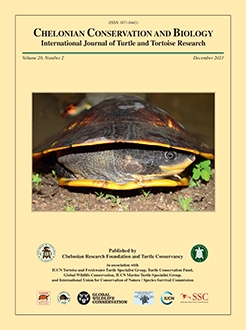The recovery of depleted sea turtle populations will require careful documentation of sea turtle reproduction sites and anthropogenic mortality risks throughout their known ranges. Although sea turtle nesting is well documented in many locations, there remains a paucity of data on the species and nesting ecology in western Africa. Here we provide the first longitudinal study of sea turtle nesting activity in Ghana. In decreasing order of abundance, we observed nesting olive ridley (Lepidochelys olivacea) (60 nests/yr), leatherback (Dermochelys coriacea) (17 nests/yr), and green (Chelonia mydas) sea turtles (2 nests/yr) along 3.7 km of beach. The primary nesting season for all species is September through January; however, olive ridley turtles sporadically nest throughout the year. Olive ridley nesting activity significantly declined during the study period (R2 = 0.53, p = 0.04). The primary risk factors for these animals are fishery bycatch, direct harvest of nesting females, and egg poaching.
How to translate text using browser tools
1 November 2021
Sea Turtle Nesting Activity in Ghana, West Africa
Andrews Agyekumhene,
Prince Yankson,
Leyna Stemle,
Phil Allman
ACCESS THE FULL ARTICLE
Chelonia mydas
Dermochelys coriacea
Ghana
Lepidochelys olivacea
sea turtle nesting
threats
West Africa





